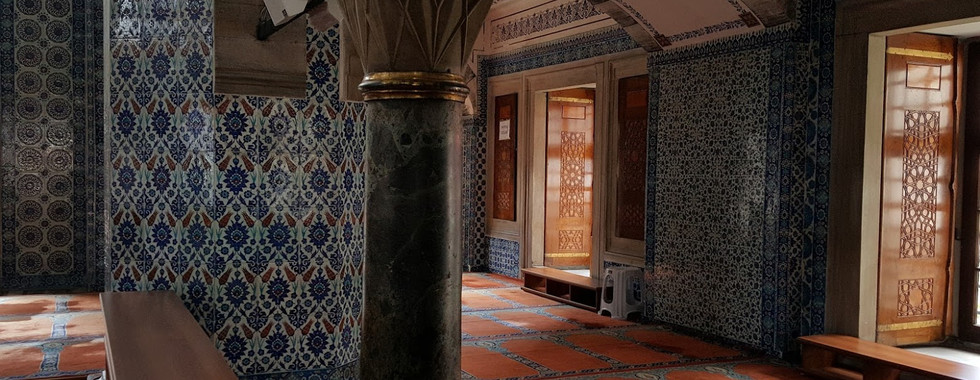Dreams of Istanbul
- tomherndon2010
- Nov 20, 2023
- 9 min read

I had the privilege of wandering Istanbul's historied streets for close to three weeks. I moved from being a tourist in a rush, to feeling more like a local. I became familiar with the place enough to give directions to harried sightseers.
Turkey sits between Europe and Asia, a crossroads for much of the world’s cultures. Can you imagine living in a city of eleven million people steeped in the rich, diverse, and colorful customs of two of our largest continents?
The city is a mesmerizing fusion of beauty, exoticism, antiquity, and dread. The sites are extraordinary, the history mind-boggling. The Hagia Sofia was initially intended as a Christian church to be constructed on the site of a Pagan temple in 325. It was finished in the 6th Century between 532 and 537 when Istanbul was Constantinople. It served as a cathedral for nearly a millennium, then was repurposed as a mosque in 1453. The remnants of its history can be observed in the fading mosaics and structure, reflecting a fusion of two prominent global religions.
Mosques of every size, from small and tucked away behind a shop or a cafe, to grand and majestic, like the infamous Blue Mosque, surrounded by tall, thin minarets. The more minarets the wealthier the man who built the mosque. Muezzins use modern technology to broadcast their prayer calls from tall minarets. I stood on a corner near the Grand Bazaar and there were three different calls filling the air. Many of the mosques were open to the public, though women were not allowed in unless they covered their head. Scarves were available near the entrance. No one wore shoes.
The elaborate tile work, the attention to ornamentation, the colors! Inside these sacred places, I imagined prayer time for generations of Muslims, cherishing the precious moments nurtured by ancient silence. The feeling of profound peace is something I will never forget.
In Istanbul, passion and aggression coexist. You have to be sure of foot, as the streets, stairs and sidewalks are frequently in disrepair. You need to be confident, and strong in your resolve, for you’ll be pushed and pulled by locals trying to sell anything and everything. They’re not always polite about it.
In order for me to relate to such a venerable city, I had to call her the Paris of the Middle East. The comparison hardly fit, though it served me with some much needed context. If Paris is a beautiful, mature woman with style, wisdom and grace, Istanbul would be her older, more eccentric auntie. Elegant and mysterious, she’s much more worldly wise, having learned what it takes to survive over two millennia. Her elderhood is apparent. Deep lines from living a long and magical life are etched into her ancient face.

As a tireless foodie and an insatiably curious cook, I dipped my toe into researching the city’s food culture. Humbling to say the least. The food was earthy, deeply flavored and fresh (much of what I ate was cooked right in front of me).
No one eats alone. Sharing is essential. Should you find yourself at a table by yourself, you’ll share with the folks sitting next to you and they’ll tear off a hunk of lamb and some bread and share with you.
Bread is sacred. No one throws away bread. At worst, leftover pieces would be placed on a wall or windowsill for someone to grab. Locals have a saying that translates to “Bread never gets dirty.”
Fast food doesn’t have near the value as dining together. Sharing a meal is an act of communion, a time of heartfelt connection. Mealtime is for savoring the richness, the privilege, the gift of being able to nourish oneself, and each other.
For many Americans, eating as a sacred experience is relegated to the holidays, specifically Thanksgiving and Christmas. Despite our natural, human longing for a deeper connection, these peak moments are considered rare blessings. For Turks, eating as a sacred experience is a vital part of life – a day-to-day practice.
So very grown up.

Balik Ekmek
This fish sandwich was a must-have.
For most of a century, fishermen brought their catch from the Bosporus and the Sea of Marmara to Istanbul’s Galata Bridge over the Golden Horn, to sell. A few enterprising boatmen had an idea: why not cook the fish right on the boat and offer it for sale, freshly cooked? They built grills right in their boats. Every day over open fires they grilled fish fillets, stuffed them into half a loaf of bread, and handed the fish sandwiches to hungry but thrifty locals.
One of the more popular places to grab a Balik Ekmek sandwich is from one of the ornate boats at the foot of the Galata Bridge. Along the shores of the Bosporus, and throughout the city, are also street vendors with homemade grills, and long queues.
Keep the bread, I want the fish!
Döner Kebab
The most famous kebab in the world is the döner kebab which literally means “rotating kebab” in Turkish. Before taking its modern form, the ancestor of the döner was the “Çag Kebabi” mentioned in Ottoman travel books from the 18th century. A horizontal stack of spicy lamb from the eastern province of Erzurum. Ours was served by a bearded young man in a red fez.

Döner is the ultimate classic Turkish dish, similar to the Shawarma sandwiches we’re familiar with at home. Delectably thin slices of savory meat cut off of a turning, slow-roasting cone of layered lamb, beef or chicken (often a combination). Sometimes wrapped in pita, sometimes rolled in thin Aram bread. Additions like falafel, vegetables and sauces differ with every cook.
Dönor shops proliferate the city. Unfortunately, many are considered fast food because they use prefabricated dönor “loaves.” Kinda like a big Turkish spam. Yag.
In my research there have only been a small number of döner kebap chefs who have received rave reviews. One of the better chefs does something remarkable. He layers fresh tomatoes, onions and peppers in between the succulent lamb and beef filets. His shop is just over the Galata Bridge and up the hill a few blocks.
Chef Burat’s place is not your run of the mill döner, It rises above a very crowded marketplace. It takes two hours to build his döner kebap, stacking paper thin layers of raw lamb and beef. Thin slices of green pepper, onions, and fresh tomatoes between the meat add tons of moisture, extra flavor and makes for a beautiful presentation.
Took some doing but I found it. This is Chef Burat. Slicing away at his wonderful döner kebab. He wants to stop but I tell him to keep going. Then he points to me letting his friends know I am a chef from California who is making him famous on the internet. His glass of çay within reach.
Mine came on a toasted baguette roll. After he toasts the bread he smooshes it into the savory juices collected below. The meat was tender, the beef-lamb combo was brilliant, the veggies soft with a slight crunch of the peppers.
I scarfed it in six bites.
Sweets
It was a long walk back to the Kunefe vendor. It was sunny, I was thirsty, and I kept passing these enticing (fresh-squeezed) pomegranate juice vendors. So I grabbed one.
A juice, not a vendor. Although…
Turks LOVE their sweets. For every savory food restaurant with big windows to watch from the street, there were two sweet shops. Giant piles of serious craftsmanship, long queues of locals waving and shouting out their orders, busy servers hurriedly filling custom boxes with all manner of sugary treats. Just standing and watching this ritual was fascinating. Even in the patisseries of Paris, the passionate exchange between customer and shop was not near as serious.
In the windows of these shops were tall, dramatic pyramids of sweet delicacies. Baklava, the most famous sweet, dates back to the Byzantine Empire. The recipe was developed and refined during the Ottoman Empire and is the baklava we know today, made by stuffing layers of filo dough with nuts such as pistachio, almonds, and hazelnut, then drenching it in honey syrup.
Many shops, particularly in the Grand Bazaar, sold nothing but Turkish Delight. Mounds and mounds of jewel colored gels made from cornstarch, fruit paste or nuts, and sugar. Famous all over the world, Turkish Delight was first made in the 18th century, by a candy maker during the Ottoman Empire. Soft and fluffy, pretty in a china bowl for teatime, they are a lovely chew.
There was a kunefe vendor up the alley from the Spice Market. He browns a buttery, shredded filo and cheese-stuffed pancake in small round metal pans suspended on a grate over hot wood coals.
When both sides are browned he drizzles the hot cake in sweet syrup and powders the top with pistachio. Savory and sweet, crunchy and chewy, addictive as hell.

Three times. I went back three times!
Manti
When I relocated from my first apartment near Taksim Square, one of the rougher neighborhoods, across the Galata Bridge, to Sultanahmet, a tonier, shinier, cleaner nabe, I found a little café I returned to a few times. It was peaceful, the service was polite and unobtrusive, and the food – well, the one dish I kept ordering – was as delicious as it was comforting.

Manti are mini-dumplings filled with spiced ground lamb, boiled like ravioli, and served on a garlicky yogurt and butter sauce. Mine came with a nice ladle full of lamb ragu on top. Can you blame me for going back time after time?
I called the place Ungapatchke Café. One of my favorite Yiddish words, Ungapatchke means overly ornate, busy, ridiculously over-decorated, garnished to the point of distaste. The ceiling was hung with a hundred glass lamps. The place was stuffed with wall-to-wall antiques. Mirrors and framed art everywhere. I told my husband that it looked like some queen threw up in here.

Despite the out-of-control look of the place, the manti were consistently delightful.
Plus a glass of çay, of course.
Çay (pronounced chai)
Sharing a moment to connect while having a cup of tea (actually a small tulip-shaped glass), is a big deal. Kiddie tables and tiny stools were anywhere and everywhere. Set up in the most unlikely places because having tea is not about where, it's about who and when.
Just as the loudspeakers from Mosque minarets blast prayers five times a day, sharing a cup of çay occurs multiple times during the day. Turkish citizens can drink two or three cups of tea every day on average. Turkey consumes more than three and a half kilograms of tea per person every year and are on the top of every tea consumption index, usually followed by Ireland and the United Kingdom. I had dinner with a local woman who told me for her, fifteen times a day.
The word çay is a derivative of the word Chinese who brought tea to Turkey. Though it’s pronounced chai, it has nothing to do with the spice-laden, milky version we know.
Local shop keepers pay a monthly stipend to the çay vendors and are issued tokens. The çay is delivered to the shops on request by men or boys carrying small metal trays. Tokens are exchanged for tea and when the tokens run out they buy another month's worth. A very common tradition among shopkeepers in Turkey is to have tea with their customer. It shows hospitality and should not make you feel obligated to buy anything.
All over the city you see young men carrying these trays to and from shops. If you are a known customer especially, you can count on tea arriving soon. One tiny shop on the food tour I took, tucked back in a dark corner behind tumble-down stone walls and ancient tiles – a well-hidden gem, if you will – served traditional baklava with a glass of çay. The shopkeep made the call and the çay arrived a minute later in a box via long pulley’s from two stories up. Unusual and little out-there to us, perfectly natural - perfectly essential – to the locals.
Tea is serious business. Nearly every market had a choice of tea sets. After seeing a hundred, it became clear that there was a small handful of vendors selling them to the markets because the tea set styles repeated over and over again. One unusual set I called blingware. The cups and the pot were covered in rhinestones.

Having çay together is the ritual. Sharing the moment to connect with each other is the purpose.
Very civilized.
All in All
Living in San Francisco for over 40 years I’m quite familiar with which neighborhoods and sites to avoid, as they are rife with tourists. For example, unless I really have to, I never go to Fisherman’s Wharf. That may sound harsh, but it was a long, long time ago that it was a place of magic to me. A young boy from Northern California, hardly ever been to the big city, hearing about Fisherman’s Wharf for years, romanticizing about clam chowder and cracked crab and the foreboding stories of Alcatraz, the prison on an island in San Francisco Bay. C’mon, the Birdman of Alcatraz!
Taking my first step onto the Golden Gate Bridge after dreaming about it forever, was like having a close encounter with a celebrity. I was star-struck. When these exotic landmarks, these iconic symbols of world-travel, are new, they retain their three dimensions. Over time, with growing familiarity, they sink back into two dimensions. Today, I drive the GG Bridge three or four times a week. From time to time I remember where I am and get briefly back in touch with how wonderous it all is.
My desire to be in Istanbul long enough to experience being more a local than a tourist, was surprisingly bittersweet. Easing my way over that threshold brought with it a disappointing familiarity with the day-to-day struggle to survive in a big city. The shine of novelty was dulled. After a dozen times walking by one of the most famous shrines on the planet – the Blue Mosque – my sense of awe diminished.
However…
I felt at ease as I walked the streets. My fear of standing out, being a tourist-target, fell away. I felt confident, sure of foot, and comfortable speaking with locals.
Under the sheen of newness was an unfathomable reservoir of history. To feel more connected to, safe with, even embraced by, the “older, more eccentric auntie” was incredibly fulfilling.
Taking the time to transition was well worth it. Maybe the novelty is gone, but now I know where to go, and what to do, when I return.
I wouldn’t have it any other way.












































































Comments